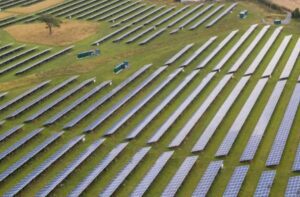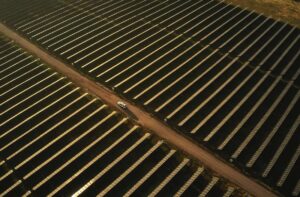Telstra has signed a contract to build a 70MW solar farm in north Queensland in a bid to cap energy costs, and as the first part of its long-awaited rollout of the Telstra Energy strategy, which may see it compete against major utilities.
The company says it has signed a long-term contract to buy the output of a new solar farm near Emerald, which will be built by RES Australia. In doing so, it is following in the footsteps of Sun Metals, the zinc producer building its own 116MW solar farm, and Monash University, which has tendered for a 40MW wind farm or solar farm.
All are investing directly in renewable energy to reduce their electricity costs, which continue to soar in Australia as network costs and wholesale prices rise unchecked.
The deal was unveiled by Ben Burge, who Telstra snapped from Powershop last year to head its new Telstra Energy division. He says it is an important step in Telstra’s strategy to more actively manage its energy consumption and costs, and to reduce emissions.
“We are proud to be taking an active role in Australia’s transition to a lower emissions economy, complementing our long-standing energy efficiency and sustainability programs that saw our emissions intensity per unit of data fall by 56 per cent over three years,” Burge said in a statement.
“The Emerald project is part of Telstra becoming a more active participant in the energy market to reduce costs while at the same time building resilience in our network and contributing to a more stable energy system.”
Telstra is being coy about how many other contracts it may sign for solar or wind farms, but it expects the corporate PPA market in Australia to finally take off, as businesses understand that renewable energy is a cheaper option to the grid.
“This is about managing risk,” says James Gerraty, Telstra Energy’s head of strategy.
Meanwhile, Telstra is planning to invest heavily in solar at its exchanges and building across the country, and will aggregate its back-up generators to play in the wholesale market. But it appears to be backing off a push into the home solar and storage market. (See our full interview with Gerraty here).
Construction of the Emerald solar project will begin in the second half of 2017 and electricity generation is expected to commence in 2018.
It will be feature single axis tracking technology, and is one of 18 committed large scale solar projects in Queensland that are creating thousands of jobs, highlighting the fact that the regional economy is not as dependent on the Adani coal mine as many think.
RES Australia’s chief operating officer Matt Rebbeck said the PPA (power purchase agreement) with Telstra was critical to underwrite the $100 million project, and is the first of the company’s large-scale solar farms to be built.
“It is great to have been able to apply our global experience in long-term power purchase agreements to tailor the deal around Telstra’s requirements and enable new renewable generation to be brought online,” he said in a statement.
“This 160ha new solar plant will be one of the largest renewable energy sources in northern Australia and will create jobs and economic opportunities in regional Queensland.”
RES says the Australian market for corporate PPAs is poised for significant growth due to rapidly accelerating electricity and gas prices.
It says it has a significant pipeline of solar projects across key states, alongside a high quality wind farm development portfolio, and energy storage.
This article was originally published on RenewEconomy’s sister site, One Step Off The Grid, which focuses on customer experience with distributed generation. To sign up to One Step’s free weekly newsletter, please click here.









